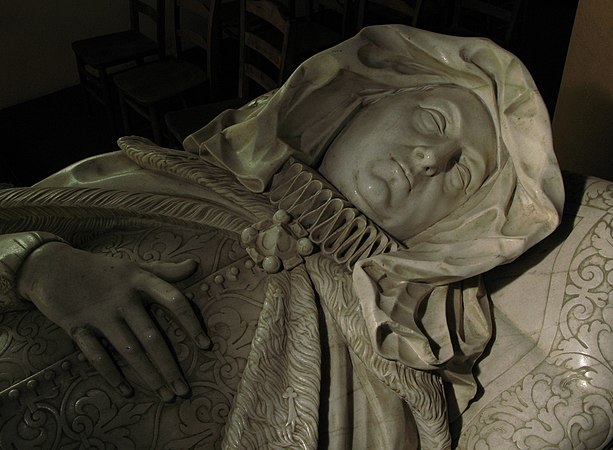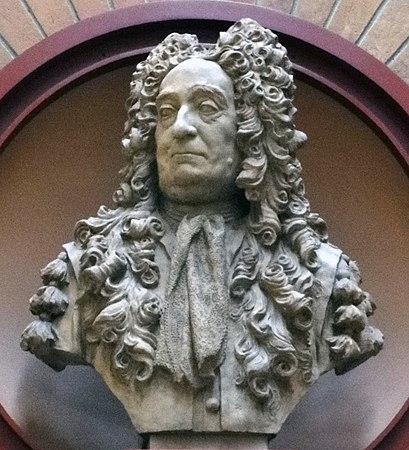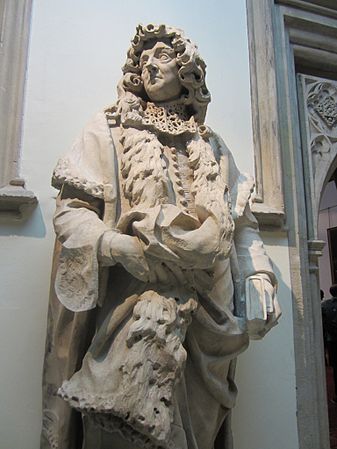Early Baroque sculpture in England was influenced by an influx of refugees from the Wars of Religion on the continent. One of the first English sculptors to adopt the style was Nicholas Stone (Also known as Nicholas Stone the Elder) (1586–1652). He apprenticed with another English sculptor, Isaak James, and then in 1601 with the noted Dutch sculptor Hendrick de Keyser, who had taken sanctuary in England. Stone returned to Holland with de Keyser, married his daughter, and worked in his studio in the Dutch Republic until he came back to England in 1613. Stone adapted the Baroque style of funeral monuments, for which de Keyser was known, particularly in the tomb of Lady Elizabeth Carey (1617–18) and the tomb of Sir William Curle (1617). Like the Dutch sculptors, he also adapted the use of contrasting black and white marble in the funeral monuments, carefully detailed drapery, and made faces and a hands with a remarkable naturalism and realism. At the same time that he worked as a sculptor, he also collaborated as an architect with Inigo Jones.[28]
In the second half of the 18th century, the Anglo-Dutch sculptor and wood carver Grinling Gibbons (1648 – 1721), who had likely trained in the Dutch Republic created important Baroque sculptures in England, including Windsor Castle and Hampton Court Palace, St. Paul’s Cathedral and other London churches. Most of his work is in lime (Tilia) wood, especially decorative Baroque garlands.[29] England did not have a homegrown sculpture school that could supply the demand for monumental tombs, portrait sculpture and monuments to men of genius (the so-called English worthies). As a result sculptors from the continent played an important role in the development of Baroque sculpture in England. Various Flemish sculptors were active in England from the second half of the 17th century, including Artus Quellinus III, Antoon Verhuke, John Nost, Peter van Dievoet and Laurens van der Meulen.[30] These Flemish artists often collaborated with local artists such as Gibbons. An example is the equestrian statue of Charles II for which Quellinus likely carved the relief panels for the marble pedestal, after designs by Gibbons.[31]
In the 18th century, the Baroque style would be continued by a new influx of continental artists, including the Flemish sculptors Peter Scheemakers, Laurent Delvaux and John Michael Rysbrack and the Frenchman Louis François Roubiliac (1707–1767). Rysbrack was one of the foremost sculptors of monuments, architectural decorations and portraits in the first half of the 18th century. His style combined the Flemish Baroque with Classical influences. He operated an important workshop whose output left an important imprint on the practice of sculpture in England.[32] Roubiliac arrived in London c. 1730, after training under Balthasar Permoser in Dresden and Nicolas Coustou in Paris. He gained a reputation as a portrait sculptor and later also worked on tomb monuments.[33] His most famous works included a bust of the composer Handel,[34] made during Handel’s lifetime for the patron of the Vauxhall Gardens and the tomb of Joseph and Lady Elizabeth Nightengale (1760). Lady Elizabeth had died tragically of a false childbirth provoked by a stroke of lightning in 1731, and the funeral monument captured with great realism the pathos of her death. His sculptures and busts depicted his subjects as they were. They were dressed in ordinary clothing and given natural postures and expressions, without pretentions of heroism.[35] His portrait busts show a great vivacity and were thus different from the broader treatment by Rysbrack

Post time: Aug-24-2022


